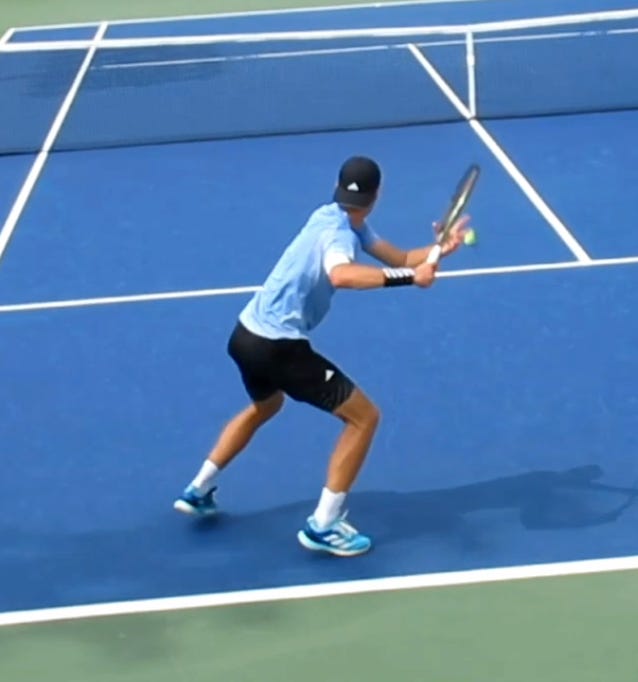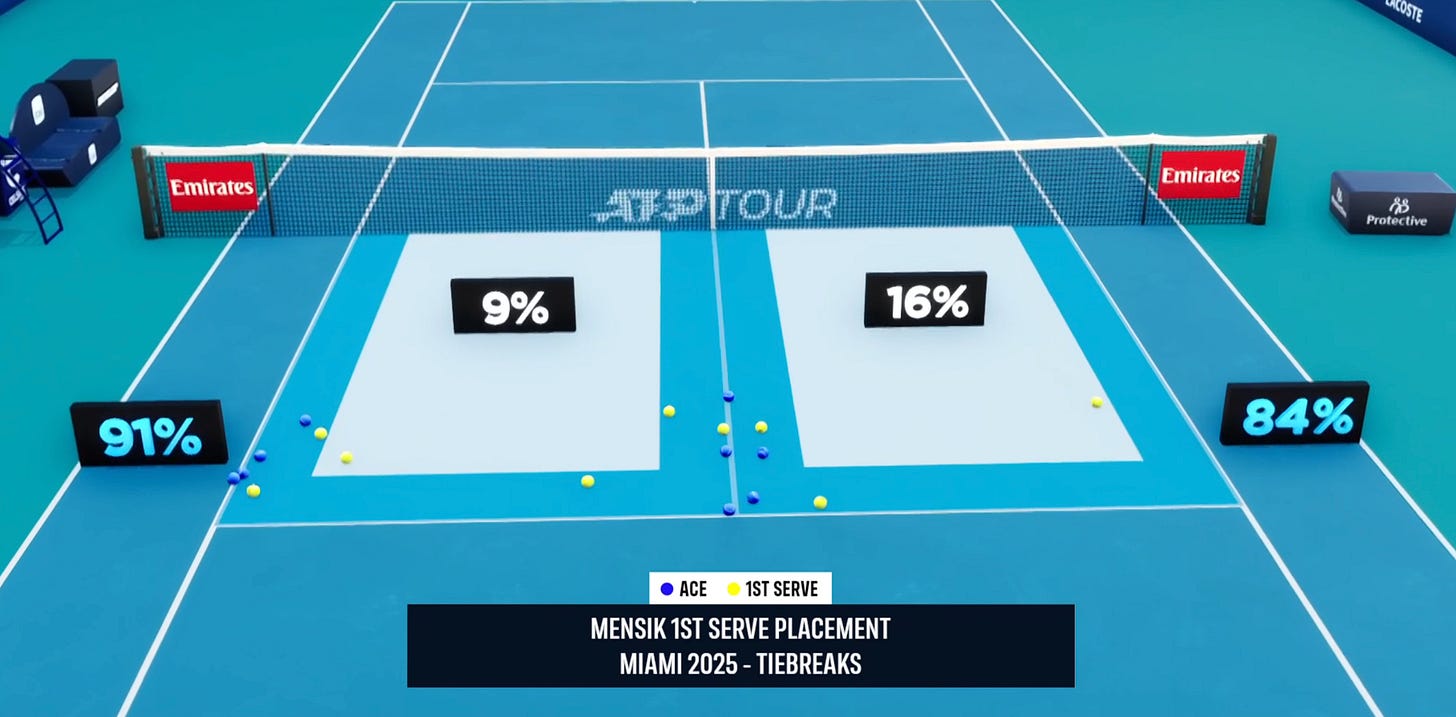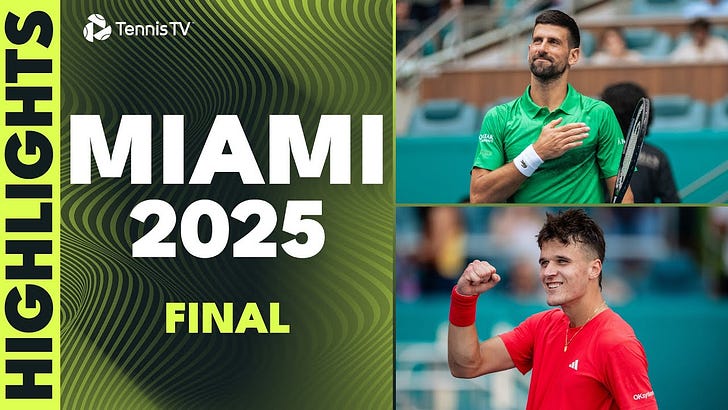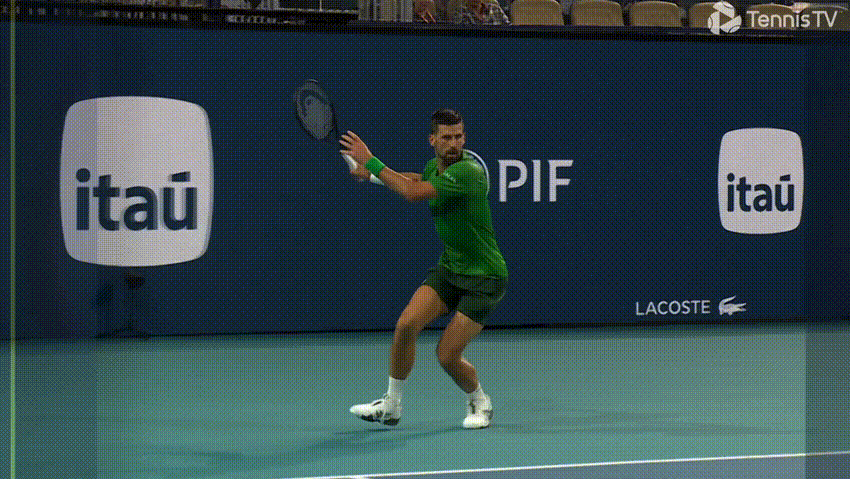Djokovic vs Mensik: Miami Masters Final Recap
serves — backhands — forehands — slice — movement — mentality
Czech teen Jakub Mensik defeated Novak Djokovic 7/6 7/6 in the final of the Miami Masters on Sunday to claim his first ever title and tie his H2H with his Serbian idol at 1-1.
I had Mensik penciled in as a Hurkacz-styled ‘big-serving counterpuncher with a leaky forehand’. He was certainly delivering on the big-serving tag during Miami, eclipsing all but the off-the-charts GMP for serving prowess, according to Tennis Insights.

“Mensik interestingly has the biggest difference between his first and second-serve speeds in the top 50 of the ATP rankings. His first serve averages 130mph. His second serve averages just 95 mph.”
— Tennis TV
Part of the reason Mensik has such a big disparity between his first and second serves is due to the fact that he often hits a genuine kick serve on his second serve. The racquet speed is in service to spin, not speed. But in Sunday’s final Gill Gross mentioned that Mensik increased his second serve average speed by 13 mph and only hit one double fault for the tradeoff. It’s likely the Czech did this knowing how dangerous Djokovic is at attacking slower kick serves (see: Nole’s Australian Open clash against Alcaraz), and felt a faster, skiddier second-serve was a good tradeoff to keep the Serb’s return aggression in check.

It’s a beauty of a motion, and at just 19, there is room to grow and improve, especially considering that he worked with Mark Kovacs to tweak the motion only last year. Kovacs is probably the most knowledgeable guy going around on serve mechanics and how to squeeze more juice out of a motion. Taylor Fritz had kind words to say following his semifinal defeat:
“The spot serving today was insane. I really should have just started guessing and picking sides more often instead of trying to react and use my reach like I normally do. I felt like either he missed the serve or he hit it within an inch or two of the line. I really should have just started guessing.”
Then there is the Czech’s other strength: his two-handed backhand.

Observe the high power position in the setup (where the racquet head is above the hands) and fuller turn with the racquet-head more in-line with the hands. He has that locked-wrist follow-through feature that you can discern given how high his right elbow gets in the follow through, and how the racquet is more upright (and often pointing right from this POV). This is Djokovic-esque: gravity for power, locked-wrists for control.
However, as good as the serve and backhand are, many have pointed out that there is a weakness on the forehand wing. Few (if any) have explained why.
So let’s compare two forehands of different fates from the Nextgen class of 2024: Mensik vs Fonseca.
Here I’ve screenshotted the unit turn positions of both players when given an easy centre ball that landed ~ the service line. It’s not apples-to-apples because no two balls are alike, and the players are in different stances/court positions, etc., but the point I am going to make still stands because backswings are pretty stable in this regard.
Already we can see that Fonseca has a higher power position. His hitting hand is higher, and his racquet head is well above his hand compared to Mensik.


Now what happens next is where the fates of shots are often written.
Let’s compare what happens during the rest of their backswings, during 'the flip’:
Look how Fonseca starts to uncoil his body and arm while the racquet head is still above and outside his hand. That produces a great stretch-reflex. In contrast, Mensik seems to actively place his racquet head down beneath his hand and the ball and then begin to uncoil. This is what a gravity versus non-gravity forehand looks like, and there is no way to make up for such a deficit. It’s like racing your friend on a push bike, but they get a rolling start off a hill.
What’s the backswing tradeoff here? Mensik gets into the slot position earlier, but he has a harder time accelerating the racquet in an effective way out of the slot; it’s a weak stretch. Fonseca’s racquet ends up flying out of the slot position because it’s flying into the slot. The stretch on his internal shoulder is huge and snaps the racquet forward far more effortlessly.
This is also why you’ll sometimes see Mensik just hit a forehand that barely makes it halfway up the net. I don’t think it’s a coincidence that it occurred off a low and slow Djokovic backhand:
These swing differences are revealed in shot speed and spin data. 1

And in winner and make percentages. Last year Fonseca hit more than twice as many forehand winners as Mensik and fared only 2% worse on in-percentage:
I’d wager that the pattern of these differences will hold for their careers, and it’s why I’m prone to saying that at the top the game, where fitness is more easily improved than mechanics, that ‘tennis is a backswing game’.
Sub-optimal mechanics aside, Mensik’s forehand was not leaking, at least not on Sunday. In fact, he closed out his opening service game with a very confident flat inside-out forehand that forced a miss from Djokovic:
Djokovic’s own forehand had been squeaky clean in his semifinal win over Dimitrov, committing zero unforced error for that match, but he started his first service game here with two unforced errors — one off each wing — to help the young Czech to a perfect start: a break of serve.
Mensik made good on the break, showcasing the other, other strength I haven’t mentioned yet: for a statistical serve-bot, the kid’s movement is unreal:
At 3-1 and 4-2 Djokovic started to employ more slice into his groundstrokes. Given Mensik’s flat backhand, and his flat, slower-swing forehand, I thought this would be a key tactic of the Serb’s in this match.

Djokovic would earn the break back, capitalising on his first — and only — break point of the match. What was puzzling to me, is that Djokovic didn’t go to the slice again as deliberately as he did in this 4-2 game for the rest of the match.
I was listening to Intuitive Tennis’ recap of the match, and he mentioned that he caught some of the Djokovic box instructions in this 4-2 game, which were to stand closer to return serve. It makes sense, and I assume it was based on some good homework, given Mensik barely hit body serves all week.
Another wrinkle in the Mensik forehand is how often he play his short middle forehands open stance, even when approaching the net. He uses something like an extreme semi-western forehand grip, and more extreme grips usual demand more extreme torso rotation, so front foot forehands become difficult.2 The problem is that your momentum doesn’t carry you forward to the net very well when you do that:

Federer was one of the best at skipping around middle balls and finding the front foot on his approach, seen here against Djokovic’s coach:

Anyway, Mensik held, and we found ourselves in a tie-breaker for the first set before Tennis TV flashed this impressive graphic

Right on cue, the Czech blasted an ace out wide to open his tiebreak account, and never looked back. He would race out to a 5-0 lead and close out the first set 7-4.
The Czech didn’t let up in the second. There was no lull or slump that you might expect from a 19-year-old playing his idol. We just got shots that were tributes:
It must be said that Djokovic wasn’t playing his best, especially from his forehand side, but there were moments when the frustration and concentration coalesced into something akin to his best stuff:
That level of aggression maybe said more about Mensik’s defence and movement more than anything else. And to make things all the more frustrating, Mensik just stepped up and bombed another ace on the next point.
Djokovic was serving better in the second, finding plenty of plus-one attacking shots, as he directed most of his serves into Mensik’s forehand, which did well to return most of them anyway (88% in). It was on return where Djokovic wasn’t making his usual inroads. The 3-4 game in the second was a good example. Djokovic had sniffs at 0-15, 30-30, and deuce, and on all occasions Mensik would simply hit an unreturnable serve:

At 4-5 Djokovic again opened his account with a win on the first point, weathering a hard cross forehand from Mensik (again note how it sits up nice and high for the Czech to flatten out) and winning the cat and mouse exchange.
But true to this match’s theme, Mensik simply reached back and rocked a few more aces and was out of the game four points later.
In the tie-breaker, Mensik got out to a 2-0 lead. Again, Djokovic found relief with the slice, taking control of this point once he got Mensik to slice back to him and buy him some time to attack the forehand.

At 2-2 the pair played out a brutal exchange that ended with Djokovic dumping a forehand in the net before collapsing on the court.
Again, Mensik backed up that lung-buster with another unreturnable serve. At 3-4 Djokovic went to the slice again, going first cross, getting a meek slice back, and then slicing down the line into the Mensik forehand. This worked, because Mensik shanked his forehand. Unfortunately for Novak, he shanked it high enough and deep enough to pressure the Serb’s own ball, which he dumped in the net.
That mini-break was enough for Mensik in this serving mood, and he served out his first match point with another unreturnable serve.
He finished the match with 56% (!) of serves unreturned (18% were aces). That was worse than his tournament average of 60% unreturned. Both numbers are wild.
Style and level: where does Mensik fit?
It’s hard to predict these things because young players improve at different rates. Some patch weaknesses, improve strengths, change styles slightly, etc. Stylistically, I still think the Mensik/Hurkacz comparison is broadly right. Both serve big, move well, hit flat, and aren’t averse to coming forward. They differ in that Mensik may well be better than Hurkacz in nearly all departments: serve, forehand, backhand, and movement, and he is likely more aggressive, as is the trend with youngsters these days. Yes, his quick-in-the-slot-watered-down forehand swing will always struggle to deliver hammering blows, but in this match he showcased that he is able to handle pace and redirect down-the-line from close baseline quarters out of forehand-to-forehand patterns. He can also flatten it out pretty effectively from higher contact points, given his height and more extreme grip:
“When you lift it up to his [Mensik’s] forehand, that's when he can actually flatten it and do more with it.”
— Taylor Fritz
Faster hardcourts (like Miami, unsurprisingly) are going to be his wheelhouse.
Still, the forehand is an obvious weakness, and I would wager that his performance in this final won’t be par for the course, but something closer to a “good” Mensik forehand day. Whether that ultimately matters or not will probably depend on how often he can bottle that kind of serving, which will always give him a chance in a match.
Mentally, this match was notable because the Czech didn’t blink once. We have to remember that this was his very first ATP Final, and it just happened to be a Masters 1000 against his idol. He could have been forgiven for having a lapse. Instead, he showed some rare poise.
Mensik went seven-for-seven in tiebreaks last week in Miami, and no opponent won more than four points in any of them. That’s impressive, but also lucky. Jeff Sackman of Tennis Abstract wrote an insightful, if not sobering (for Mensik fans), piece on just how unlikely that was, based on the Czech’s serve and return numbers. A screenshot:
So far the Czech has performed better than expected in tie-breakers, not just in Miami, but for his career. He wins more serve points in breakers (78%) compared to his regular game serve win percentage (65%). It may be that his serve is that good; that he can lock in and find an extra gear when it matters. We’ll need more data before we can assess if that notion holds any water.
For now, Mensik has put himself inside the world’s top 25 and earned a very impressive 13th on TA’s elo rating, which accounts for who you beat, not just the round/event.
At the end of last year I wrote of the upcoming 2024 Nextgen tournament:
So, who from this field will make the biggest splash in the coming years? I feel pretty confident that Fils and Mensik will break into the top-10 and make deep major runs at some point, and Shang and Michelsen have also shown potential over the course of the year, but despite being the last man (boy?) to qualify, I still think 18-year-old João Fonseca has the biggest upside.
This is still my position.
Mensik is a top 10 guy. That, I have no doubt. After the match the Czech signed off on the camera with “1st of many”. The question is, many of what?
Can a big-serving counterpuncher win slams? Recent history suggests it is exceedingly difficult, and that the modern game rewards the combined proficiency of your forehand and backhand over a “serve plus one groundstroke” style. This is because elite groundstrokes help you hold serve a lot — even with a mediocre serve — but a great serve doesn’t help you break serve at all.
Case in point: Nadal is top 25 for service games won based on ATP career data.
Plus, winning slams often means you run into one of these elite forehand/backhand groundstroke players (Sinner, Djokovic, Alcaraz, Nadal) while they are in form, and that usually means they have the tools to take apart a weak groundstroke. We saw that in Australia recently. Zverev said as much post-match:
“I serve better than him. He [Sinner] does everything else better than me.”
For now, I’m looking forward to watching the young Czech more as the tour moves to clay, and now have him penciled in as a “ridiculous-server with a not-so-leaky forehand”.
That would certainly be trouble for top guys.
See you in the comments. HC.
This is also why you’ll sometimes see Mensik just hit a forehand that barely makes it halfway up the net. Skill issue.
Sinner is an exception who loves to get on his front foot and of course, he has elite racquet head speed.


















mensik remind mein your analysis to someone like zverev ! you mentioned hurckacz fair enough but mensik mooves like zverev which is better than hubert imo even though its close ! forehand weakness is spot on just like zverev and hubert ! one of the reason i have doubt mensik could win a slam just like zverev cause they are much more complete guys out there ! lets see
Hi Hugh,
A great analysis, as always. Two comments
1) About Mensik’s TB record. While I agree the 70% record is probably unsustainable and such a 7 TB win streak is unlikely to reoccur, I still think he could develop into a tiebreak king. The fact his serve doesn’t go down a gear under pressure (in fact seemingly the opposite) when in general it does (thus the points getting longer and better players winning TBs) helps, but I also think on the other end of the spectrum he is great too. His serving points don’t get longer but his return ability (one I’ve admired from the start, great reflexes and absorption off both wings including the FH) allows to make his opponent’s longer. That’s a scary short point domination combo (Jeff Sackman had showcased his 1-3s earlier in the week and he places in the Top 10). Sometimes that’s all it takes, see the easy +1 miss from Djokovic at 2-0 in the first TB.
2) Speaking of Djokovic. That piece was understandably centered around Mensik, but what do you make of this week for him? To me it was very positive, and not a negative final itself, especially when you take some circumstances (stye and high humidity) into account which may have contributed to the not-so-stellar day he had and you mentioned.
He didn’t quite get dominated, he was mostly out clutched in tiebreakers. And sure, you could say Prime (or even 2023) Djokovic would have been the clutch one (even dominated the match to a point clutch doesn’t matter) by cutting down on Mensik’s free points on serve and outlasting / exposing him in those lung busting areas (big serve return and rally endurance seemingly the two areas where he has « declined » the most), but still, given Mensik’s performance (basically no drop from the entire week) and Novak’s own throughout (dominant draw albeit not so great competition) I think the pieces are still there for a #25, especially the one that is questionable (physicality and all its aspects, from reflexes to movement / defense to rally stamina).
Wimbledon seems like a better bet than the French, but even that I wouldn’t rule out as I think he’ll keep upping physical gears (eventually being better than the Djokovic who suffered against humidity) and build momentum throughout the clay season, bar another injury which would set him back to square one (or even be the end of things).